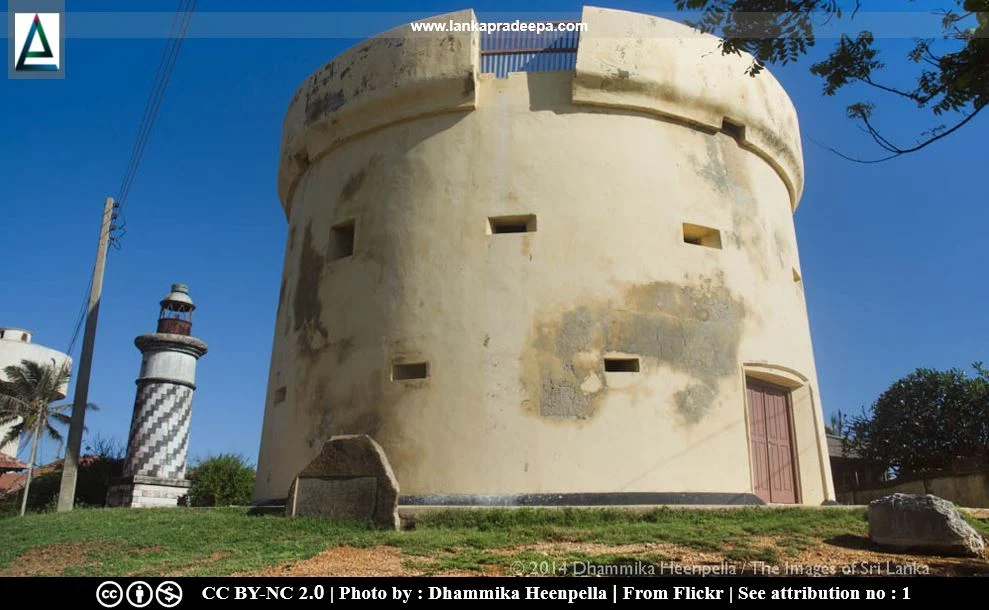
The Martello Tower (Sinhala: මාටෙලෝ කුළුණ, හම්බන්තොට; Tamil: மார்டெலோ காவற்கோபுரம், அம்பாந்தோட்டை) in Hambantota is a historical tower of the early British colonial era in southern Sri Lanka. It is the oldest structure dating from the British period in Hambantota District and the only example of this fortification type in the country (McCall, 1999; Wisumperuma, 2015).
History
Martello TowersMartello towers were built by the British in a number of their territories in the world after 1796 as a part of their military strategies. The name as well as the basic plan of these towers are related to a round tower at "Mortella" Point in Corsica, which was garrisoned by the French National Army (Wisumperuma, 2015). During the battle of San Fiorenzo in February 1794, the British troops under Sir David Dundas were impressed by its remarkable technical capabilities and strength (McCall, 1999; Wisumperuma, 2015). The British, after going through a study, adapted a tower of this type for their military purposes after 1796 (McCall, 1999; Wisumperuma, 2015). Subsequently, they built them in Cape Town, Nova Scotia (1796), St. Helena (1797), Minorca (1798), Scilly Isles on St. Mary's (1803), Ireland (1804), and England (more than one hundred were built along the south coast of England during 1805-1812), Sierra Leone (between 1805-1807), Mauritius (1834), and Delhi [(c.1824) Abeyawardana, 2004; McCall, 1999; Wisumperuma, 2015]. The towers came to know by the name Martello, an anglicized form of the French word "Mortella" (Wisumperuma, 2015).
Hambantota Martello Tower
Following the unsuccessful attack by Kandyan insurgents in 1803, the tower is thought to have been built as a defence structure to face attacks from the land side as well as from the ocean (Wisumperuma, 2015). The idea to build this tower in Hambantota came from Major General D.D. Wemyss, the then Commander of the Forces in Ceylon (Wisumperuma, 2015). He ordered Lt. William Gosset of the Royal Engineers to build a round tower to accommodate fifty people (Wisumperuma, 2015). The 1806 diary note of Sir Alexander Johnston mentions that the tower was built by Captain Goper of the Engineers (McCall, 1999).
The tower is said to have been built on the site of a Dutch stronghold (McCall, 1999). The exact construction date of this tower is not known mainly due to the lack of records (McCall, 1999; Wisumperuma, 2015). However, the first record of its existence is found in a diary note from 1806 written by Sir Alexander Johnston, the acting Chief Justice (Abeyawardana, 2004; McCall, 1999; Wisumperuma, 2015). Scholars suggest its construction date to a time between 1796-1803 (Abeyawardana, 2004; Wisumperuma, 2015). According to Wisumperuma, the construction of the tower commenced after September 1804 and was still under construction in May 1805 (Wisumperuma, 2015).
The tower was first used as a fort and then it became a building under the Public Work Department (Wisumperuma, 2015). During World War II (1939-1945), it was used for military purposes (Wisumperuma, 2015). However, the tower finally fell into a state of abandonment for many years until the Department of Archaeology, funded by the NORAD (Norwegian Agency for Development Co-operation), initiated essential repairs in the early 1990s (McCall, 1999).
Popular belief
The popular belief was that this tower was built by the Dutch who had control of the area in the 17th and 18th centuries (Wisumperuma, 2015). The Hambantota Lakara, a Sinhala book published in 1916 mentions the tower as a Dutch fortification (Wisumperuma, 2015).
The tower
Built on a small hill, it is a two-storied round gun tower (Wisumperuma, 2015). It is 25 feet tall and has a circumference of 120 feet 4 inches with a diameter of 38 feet (McCall, 1999; Wisumperuma, 2015). The thickness of the vertical wall is 4 feet (McCall, 1999; Wisumperuma, 2015). The roof is flat and the tower is surrounded by a circumferential platform which was used to move the canons around (Abeyawardana, 2004). It has two rows of windows on the tower and the windows of the upper row are bigger than the windows of the bottom row (Abeyawardana, 2004). The ground floor is believed to have been used as storage while the upper floor is for lodgings for the soldiers (Abeyawardana, 2004).
It appears that this tower has not been tested for any enemy attacks (Wisumperuma, 2015).
A protected monument
The Martello Tower at Towerhill Road in Hambantota town west No. 09 village situated in Grama Niladhari Division, Hambantota in the Divisional Secretary’s Division, Hambantota is an archaeological protected monument, declared by a government gazette notification published on 24 March 2016.
Attribution
References
1) Abeyawardana, H.A.P., 2004. Heritage of Ruhuna: Major natural,
cultural and historic sites. Colombo: The Central Bank of Sri Lanka.
ISBN: 955-575-073-4. pp.99-100.
2) McCall, M.K., 1999. The Martello tower in Hambantota, Sri Lanka. Fort Vol.27. pp.143-157.
3) Wisumperuma, D., 2015. The Date of the Martello Tower in Hambantota. Journal of the Royal Asiatic Society of Sri Lanka, pp.62-76.
4) The Gazette of the Democratic Socialist Republic of Sri Lanka. No: 1960. 24 March 2016 .p.227.
Location Map
This page was last updated on 30 April 2023

